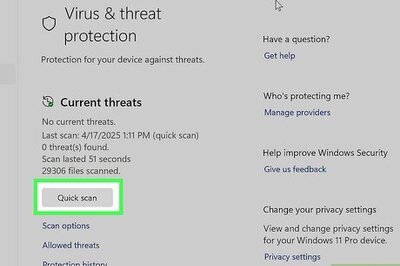
views
PHOENIX: Scammers were able to pocket nearly 30% of the $16 billion in unemployment insurance payments paid out by Arizona since the start of the coronavirus pandemic, the director of the state agency overseeing the program said Thursday.
Most of the fraud happened in the first several months of the pandemic and hit federally funded emergency unemployment insurance programs. Those programs were designed to help people who normally would not be eligible for assistance because they had contract jobs or were so-called gig workers such as Uber drivers and their employers did not pay into the unemployment insurance system.
The amount lost to fraud is between $4.3 billion and $4.4 billion, Department of Economic Security Director Michael Wisehart said. Most of that money is probably lost forever because it was siphoned off by out-of-state or overseas scammers who took advantage of the lack of identity verification early in the program.
The state was able to recover $1.4 billion it had paid out, Wisehart said. And fraud prevention systems the state rolled out in the summer of 2020 have prevented more than $75 billion in additional fraudulent payments from being made, he said.
The state was able to get more than $10 billion into the hands of workers and their families who were devastated by the massive job losses that happened early in the pandemic, Wisehart said. That’s a major accomplishment, since Arizona saw massive increases in unemployment claims that overwhelmed the ability to process them.
I feel horrible for the taxpayer, for myself as a taxpayer, for all taxpayers, that this happened, Wisehart said of the fraud loss. But Ill tell you, I would be way more angry at me and us if this was into 2021 and it extended beyond the first two or three months of the pandemic where it was true chaos.
Pandemic unemployment fraud is not solely an Arizona problem. The inspector general’s office at the U.S. Department of Labor estimated in June that states will have improperly paid out more than $87 billion of the $873 billion in special COVID-19 unemployment benefits by the time they ended on Sept. 6.
Arizona’s 27% loss rate far exceeds the national estimate. And is well above that of California, the biggest target in part because it is the most populated state in the nation with nearly 40 million residents.
California made an estimated $11 billion in fraudulent payments and an additional $19 billion was sent to suspect accounts. An Associated Press review of state losses for a March 1 story showed they ranged from several hundred thousand dollars in small states like Alaska and Wyoming to hundreds of millions in more populous states such as Massachusetts and Ohio.
Besides fleecing taxpayers, the fraud prevented legitimate payments and turned thousands of Americans into unwitting identity theft victims. Many states have failed to adequately safeguard their systems, and the AP’s review found some states would not publicly acknowledge the extent of the problem.
That was the case before Thursday in Arizona. Gov. Doug Ducey’s office and the state Department of Economic Security had declined to provide any figure for fraud losses, saying numbers were not available,
Yet Wisehart knew as early as last summer that hundreds of thousands of fraudulent claims were being made. He said last September that the agency was holding onto as many as 900,000 claims because of suspected fraud.
Wisehart said in an interview Thursday that the agency was struggling after the pandemic hit to stand up the new emergency unemployment program. In February 2020, fewer than 20,000 people were drawing unemployment. By July 2020, more than 200,000 were drawing regular unemployment and close to 300,000 people were getting the special pay for gig workers.
The state agency ended up hiring more than 2,500 workers for new call center and processing jobs and creating a new filing portal for the Pandemic Unemployment Assistance program.
The federal program’s rules said unemployed workers only had to self-certify that they were eligible and that states were not able to delay payments to verify their identity and eligibility. When the extra $600 per week in federal benefits under a coronavirus relief package ended in late July, Arizona for a time was the only state approved to offer an extra $300 per week under a stopgap Trump administration program.
That made Arizona a target, Wisehart said. Nearly 3 million weekly unemployment certifications were being filed per week, more than the size of the state’s labor force. Massive, ongoing fraud was was obvious, he said.
Arizona then implemented new identify verification programs using an outside contractor, and it began using Google Analytics to target fraudulent claims. They also suspended the ability to file retroactive claims.
That mainly worked, but the damage had been done.
Wisehart said the state’s steps haven’t eliminated scammers, but they are a vast improvement. They are now targeting people who have had their identify certified by the state for identify theft so they can get benefits.
The fraudsters are going to continue to evolve, theyre going to continue to get smarter, and were going to need to continue to work nationally to prevent this from continuing to be a pervasive problem, Wisehart said.
Disclaimer: This post has been auto-published from an agency feed without any modifications to the text and has not been reviewed by an editor
Read all the Latest News , Breaking News and IPL 2022 Live Updates here.




















Comments
0 comment